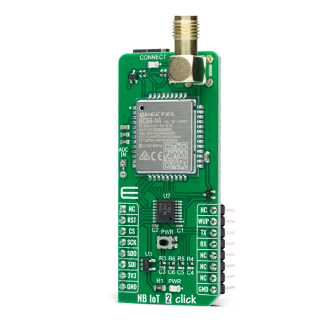
We strongly encourage users to use Package manager for sharing their code on Libstock website, because it boosts your efficiency and leaves the end user with no room for error. [more info]

Rating:
Author: MIKROE
Last Updated: 2021-04-26
Package Version: 1.0.0.0
mikroSDK Library: 1.0.0.0
Category: LTE IoT
Downloaded: 3135 times
Not followed.
License: MIT license
NB IoT 2 Click is a compact add-on board that contains a compact LTE Cat NB2 module with ultra-low power consumption.
Do you want to subscribe in order to receive notifications regarding "NB IoT 2 click" changes.
Do you want to unsubscribe in order to stop receiving notifications regarding "NB IoT 2 click" changes.
Do you want to report abuse regarding "NB IoT 2 click".


Library Description
Library provides functions for sending commands to the device, and for controlling included GPIO.
Key functions:
void nbiot2_send_cmd( char *cmd ) - Function for sending data to the devicevoid nbiot2_hw_reset ( void ) - Function for restarting the deviceExamples description
The application is composed of three sections :
void application_task ( )
{
nbiot2_send_cmd( &CGATT[ 0 ] );
Delay_ms( 5000 );
write_buff( );
nbiot2_send_cmd( &CEREGG[ 0 ] );
Delay_ms( 5000 );
write_buff( );
nbiot2_send_cmd( &CSQ[ 0 ] );
Delay_ms( 5000 );
write_buff( );
}
Additional Functions :
void write_buff ( ) - Function for writing response bufferOther mikroE Libraries used in the example:
Additional notes and informations
Depending on the development board you are using, you may need USB UART click, USB UART 2 click or RS232 click to connect to your PC, for development systems with no UART to USB interface available on the board. The terminal available in all MikroElektronika compilers, or any other terminal application of your choice, can be used to read the message.